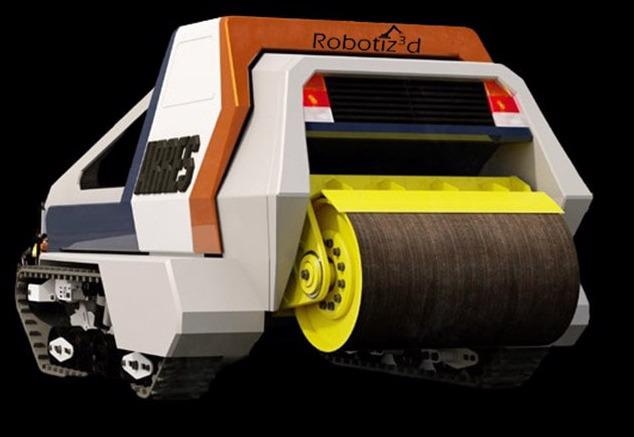AZoRobotics speaks to Dr Paolo Paoletti, CTO of Robotiz3d and Senior Lecturer at the University of Liverpool, about the development of a revolutionary pothole management robot powered by artificial intelligence. The autonomous technology may be the start of a more advanced preventative road maintenance solution set to change the future of our streets.
How did you begin your research into autonomous robots for pothole management?
The research started at the University of Liverpool about five years ago. Together with my colleague Dr Sebastiano Fichera from the School of Engineering, we began developing robotic platforms to automate construction tasks. We received some funding to sponsor a PhD studentship, which started our journey. Although our focus was initially not on road maintenance, we quickly realized that there is a big need in this market to automate processes, reduce manual labor, and improve safety.

The School of Engineering at the University of Liverpool, UK. Image Credit: ©McCoy Wynne
Recognizing the importance of commercializing our patented research and applying it to the real world, we recently formed a new University of Liverpool spin-out company – Robotiz3d Ltd – to take forward our new technology that has the potential to radically transform road maintenance. Robotiz3d is a joint venture company established in partnership with A2e Ltd and has received investment from the University of Liverpool’s Enterprise Investment Fund, alongside private equity investment from A2e Ltd.
How will the Robotiz3d pothole robot revolutionize the maintenance of UK roads? How does the technology differ from current road management practices?
At Robotiz3d, we are developing autonomous platforms capable of both road damage detection and repair.

Image Credit: Robotiz3d Ltd.
Our system will autonomously patrol roads while collecting high-quality data about their condition; it will identify defects, predict their evolution for prioritization and repair minor defects.
In the near future, we plan to repair large defects and potholes with minimal or no human intervention. This is a step-change compared to current labor-intensive practice, which often has to rely on low-quality data and expert judgment.
Our technology will allow the transition from the current ‘reactive maintenance’ practice to a more advanced ‘preventative maintenance’, where defects are identified and fixed before they pose any danger to road users.
The autonomous robot uses artificial intelligence (AI) to look for road damage. Can you explain how the technology works in more detail?
We have developed a road characterization device based on highly accurate laser scanners and bespoke smart algorithms within a project sponsored by the UK's Department for Transport.
This device can identify millimeter-sized defects on roads and fully reconstruct their 3D shape while working at the same speed as the surrounding traffic.
The robot can fix smaller cracks before they evolve into potholes. What technology makes this possible?
We have a patented technology to deposit suitable sealing materials into cracks and, by doing so, we can prevent them from evolving into potholes.
Our technology is akin to 3D printing and allows material deposition with millimeter-level accuracy to ensure we fix the crack without decreasing road skid resistance, which can be a significant problem for cyclists.
The pothole robot uses a prediction algorithm to prioritize work schedules. How does this work and why is this needed?
We are developing AI algorithms that fuse the high-quality data collected by our road characterization device with data retrieved from other sources such as weather records and traffic usage reports.
These algorithms will predict the evolution of road defects and classify their severity at different times in the future. Through access to this information, road managers will prioritize repairs to ensure that no defect ever poses a significant danger to road users.
How will using such a technology reduce road repair costs and aid in decreasing fuel consumption, greenhouse gas emissions and tire wear?
The autonomous platforms developed by Robotiz3d will drastically reduce labor costs by requiring minimal or even no-human intervention while operating. This will also improve safety by taking away risky and wearing tasks from human workers.
Our bespoke electric-powered technology significantly decreases the number of materials used to perform the repairs, substantially reducing the carbon footprint associated with road maintenance. These material savings will also be amplified by adopting our preventative maintenance technology, as, on average, the road defects will be fixed earlier when they are smaller in size.
The upkeep of high-quality road networks can play a crucial role in decarbonization and help prevent hazardous chemicals from entering our ecological environment and food chain.
A recent study led by researchers from Rutgers University has shown that a car journey on a road in a poor state of repair increases greenhouse gas emissions by 2% on average.
Bad road conditions are also a major cause of tire damage. Tire dust, which has recently been classified as a significant microplastic source in our oceans, significantly increases in quantity on poor roads. According to a recent US Tire Manufacturers Association report, although recycling helps reduce end-of-life tire disposal problems, 17% of end-of-life tires still end up in landfills. According to the World Business Council for Sustainable Development (WBCSD), one billion end-of-life tires are produced globally every year.
How does the robot recognize the presence of other cars on the road? Are there any safety features that help with this?
In this first stage of development, the vehicle will operate on closed roads due to standard and regulatory constraints. However, we envision the final platform to be fully autonomous, and we are currently liaising with autonomous vehicle manufacturers to integrate our technology into their vehicles.
What problems are present within the UK in terms of potholes, and how would your AI technology help make these issues less prevalent if it was rolled out on a wider scale?
In the UK, Highways England and local governmental bodies are relentlessly fixing almost two million potholes per annum, yet this is still not enough. Their backlog is growing, and there are more and more potholes on the roads each year.
Despite all their best efforts, the traditional methods (two-man-gang) used to fix potholes cannot cope with such spiraling numbers as they are too expensive and too slow. Therefore, a step change is needed. Robotics and AI can be the technological tools that make this happen.
With its associated shortened time for repairs and lower dependency on human labor, the adoption of our technology will quickly reduce - and ultimately eliminate - the UK’s current backlog of road repairs.
Moreover, the transition to the proposed predictive maintenance approach will enable early interventions and prevent the formation of any backlog of dangerous defects on our roads, dramatically improving safety for all road users.
Do you believe that AI technology is the future of urban maintenance?
There are significant opportunities for introducing robotics and AI in road maintenance. Innovation in this area has been scarce for a long time, but technology is now reaching a stage where it can revolutionize how our roads in the UK are monitored, managed, and maintained.
Is there a possibility for worldwide production and use of this technology?
At Robotiz3d, we are already talking to potential customers in other countries, as poor road maintenance is a global problem.
What are the challenges that may be faced if produced on a wider scale and how could these be overcome?
Reliability is a significant challenge in this field, as the technology must operate for very long times and in potentially adverse weather conditions. We are designing our platform to meet these demanding requirements.
Another major challenge is standards and regulatory approvals, as the use of autonomous vehicles and robots on open roads is still in its infancy. I am involved with the British Standards Institute and will closely monitor development in this area.
Has there been any significant commercial interest from public or private sectors to use the robot road repair system?
Our recent press release has generated a lot of interest from various public and private organizations, ranging from contractors to road managers, through to local councils. They are all very excited about our company's vision and are providing valuable feedback in our development process.
Can you briefly explain what the ‘Shape-Pot’ research project is and how your autonomous technology comes into this?
‘Shape-Pot’ was a project funded by the UK Department for Transport which aimed to produce the first incarnation of the road characterization technology that we envisioned. Through this project, a successful prototype was designed, built, and tested in our lab at Liverpool, which demonstrated that road surfaces can be monitored with high resolution and that defects can be reliably detected and their volume reconstructed. We are now further developing this technology to integrate it into our vehicles.
What are the next steps for the project?
We aim to realize the road characterization module within six months, with the autonomous platform to perform minor repairs following soon after. We are continuously discussing our design with relevant stakeholders to ensure that we can trial our technology with them and develop products that they can readily adopt.
Where can readers find more information?
Readers can learn more by visiting our website https://www.robotiz3d.com and by following us on Twitter @robotiz3d where we publish regular updates.
About Dr Paolo Paoletti
Dr Paolo Paoletti is a Senior Lecturer in the School of Engineering at the University of Liverpool and CTO of Robotiz3d.
 His research activity spans autonomous robotics, biomechanics, robust and optimal control, and nanosensing. He graduated from the University of Florence (Italy) in Electronic Engineering (Bachelor, 2004) and Automation Engineering (Master, 2006), and completed a PhD in Nonlinear Dynamics in Florence in 2010.
His research activity spans autonomous robotics, biomechanics, robust and optimal control, and nanosensing. He graduated from the University of Florence (Italy) in Electronic Engineering (Bachelor, 2004) and Automation Engineering (Master, 2006), and completed a PhD in Nonlinear Dynamics in Florence in 2010.
Before joining the University of Liverpool, Dr Paoletti was a postdoctoral fellow at the Italian Institute for Complex Systems and Harvard University in the USA. Over the last eight years, he has secured more than £7m of research funding, with approximately £1m as Principal Investigator, by EPSRC, Innovate UK, H2020, The Royal Academy of Engineering, The Royal Society, and industry partners.
Dr Paoletti was recognized as an EPSRC “Rising Star” in 2014, an award for 10 young scientists “tipped to lead internationally excellent research in the future”. He is a full member of the EPSRC Peer Review College.
Disclaimer: The views expressed here are those of the interviewee and do not necessarily represent the views of AZoM.com Limited (T/A) AZoNetwork, the owner and operator of this website. This disclaimer forms part of the Terms and Conditions of use of this website.